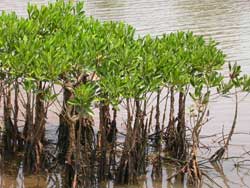Mangroves reduce Tsunami impacts

Young Mangroves<br>
The researchers, from the newly formed Disaster Research Nexus (DRN) at Universiti Sains Malaysia, hope that their work will encourage the development of better prepared communities.
The 2004 Banda Aceh earthquake and ensuing Andaman mega tsunami that caused widespread devastation and killed over a quarter of a million people worldwide was a wake-up call to many. Immediately afterwards, work was initiated to help develop human capacity and resources, and to mitigate future events. Koh Hock Lye and colleagues at the DRN developed a tsunami simulation model to investigate the role of coastal vegetation in reducing the impact of such events.
Using the model, the team analysed the earthquake risk for the Upper Padas Dam in Sabah, and found that the presence of mangroves appeared to reduce the impact of tsunamis. The research also showed that tsunamis can affect the salinity of water and soil and induce vegetative changes in affected regions.
Mangrove forests are one of the world’s most threatened ecosystems, with a fifth of the world’s mangroves having been destroyed over the last few decades. This research highlights the need to conserve them in areas where the risk of earthquakes and tsunamis are high.
The team hope that their work will improve research collaboration and allow better preparedness for seismic events worldwide.
About the Pertanika Journal of Science and Technology
Pertanika Journal of Science & Technology aims to provide a forum for high quality research related to science and engineering research. Areas relevant to the scope of the journal include: bioinformatics, bioscience, biotechnology and bio-molecular sciences, chemistry, computer science, ecology, engineering, engineering design, environmental control and management, mathematics and statistics, medicine and health sciences, nanotechnology, physics, safety and emergency management, and related fields of study.
CONTACTS
For more information on the research, contact
Koh Hock Lye
Disaster Research Nexus, School of Civil Engineering
Engineering Campus, Universiti Sains Malaysia
14300 Nibong Tebal, Penang, Malaysia
E-mail: hlkoh@usm.my
TELEPHONE: +604-653 4770.
MOBILE: +6012 456 7518.
For more information about the journal, contact
The Executive Editor
Pertanika Journals
Office of the Deputy Vice Chancellor (R&I)
Tower 2, UPM-MDTC Technology Centre
Universiti Putra Malaysia
43400 Serdang, Selangor
Malaysia.
Phone: + (603) 8947 1622 | + (6) 016 217 4050
Email: ndeeps@admin.upm.edu.my
Media Contact
All latest news from the category: Ecology, The Environment and Conservation
This complex theme deals primarily with interactions between organisms and the environmental factors that impact them, but to a greater extent between individual inanimate environmental factors.
innovations-report offers informative reports and articles on topics such as climate protection, landscape conservation, ecological systems, wildlife and nature parks and ecosystem efficiency and balance.
Newest articles

High-energy-density aqueous battery based on halogen multi-electron transfer
Traditional non-aqueous lithium-ion batteries have a high energy density, but their safety is compromised due to the flammable organic electrolytes they utilize. Aqueous batteries use water as the solvent for…

First-ever combined heart pump and pig kidney transplant
…gives new hope to patient with terminal illness. Surgeons at NYU Langone Health performed the first-ever combined mechanical heart pump and gene-edited pig kidney transplant surgery in a 54-year-old woman…

Biophysics: Testing how well biomarkers work
LMU researchers have developed a method to determine how reliably target proteins can be labeled using super-resolution fluorescence microscopy. Modern microscopy techniques make it possible to examine the inner workings…





















